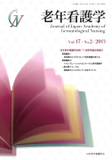Japanese
English
- 販売していません
- Abstract 文献概要
- 参考文献 Reference
抄録
目的:高齢脳梗塞患者におけるせん妄状態出現と入院初日の因子の関連および3日間のせん妄状態の変化への影響を明らかにした.
方法:対象者は5医療施設で脳梗塞の内科的治療を受ける65歳以上の患者50人であった.選定条件は,脳梗塞症状出現後1週間以内に入院し,入院時の意識レベルが清明からJapan Coma Scale I ─3の範囲で,失語症がなく,情報提供に同意した者である.せん妄の評価には日本語版NEECHAM混乱・錯乱スケール(以下,評価尺度)を用い,25項目を調査した.
結果:せん妄状態出現は11人(22.2%)で,二項ロジスティック回帰分析の結果,「右半球に損傷がある」(オッズ比=7.594,95%信頼区間=1.287−44.811,p=0.025),「脳梗塞発症から入院までに1日以上要する」(オッズ比=0.090,95%信頼区間=0.110−0.771,p=0.028)と「C反応性タンパク値が基準値外」(オッズ比=8.631,95%信頼区間=1.244−59.888,p=0.029)が採択された.潜在曲線モデルの結果,初回の評価尺度得点へ「入院時に不整脈あり」「入院時のCRP値」「入院時に麻痺MMT 2以下あり」が影響し,「入院時疼痛の程度」は初回評価尺度得点と傾きに影響した.
結論:入院直後の脳梗塞の状況,循環動態,炎症徴候,疼痛はせん妄発症の高リスク者の選別とケアに貢献すると考えられた.
Purpose: To develop effective nursing of delirium in elderly cerebral infarction patients receiving medical management who were hospitalized within the first 7 days of the cerebral infarction, the authors investigated risk factors related to development of a state of delirium on the first day of hospitalization and factors influencing the state of delirium within the first 3 days after hospital admission.
Method: Participants comprised 50 patients aged ≥65 years in five hospitals. Inclusion criteria were as follows: receiving medical management of the cerebral infarction, hospitalized within 7 days after appearance of cerebral infarction symptoms, no aphasia, consciousness level on admission of I-3 as classified by the Japan Coma Scale single-digit code range, and agreement to participate in the study. Participants' state of delirium was assessed daily with the Japanese version of the NEECHAM Confusion Scale (evaluation scale). We examined 25 items related to factors of delirium.
Results: The incidence of delirium was 22.2%. Results of logistic regression analysis showed that three factors related to incidence of delirium: stroke location in the right hemisphere (OR=7.594, 95% CI=1.287-44.811, p=0.025), a ≥1-day period from the onset of cerebral infarction to hospitalization (OR=0.090, 95% CI=0.110-0.771, p=0.028), and C-reactive protein on admission outside the reference value (OR=8.631, 95% CI=1.244-59.888, p=0.029). Latent Curve Model identified four factors influencing the evaluation scale score: arrhythmia present on admission, C-reactive protein value on admission, manual muscle testing score of ≤2 on admission, and level of pain on admission. The level of pain on admission influenced the slope.
Conclusion: The results suggested that cerebral infarction condition immediately after hospitalization, circulatory dynamics, signs of inflammation, and chronic pain contribute to determining aged patients at high risk for onset of delirium, and management of these factors may lead to the prevention of delirium onset and exacerbation of symptoms.
Copyright © 2013, Japan Academy of Gerontological Nursing All rights reserved.


